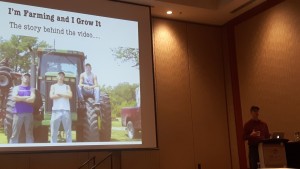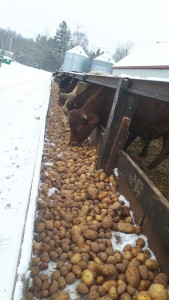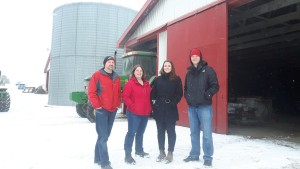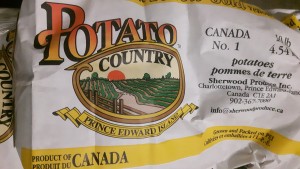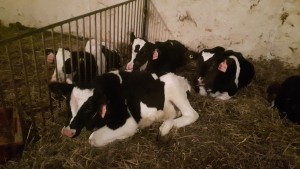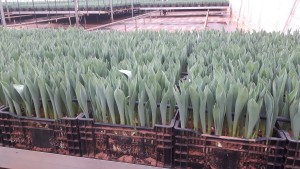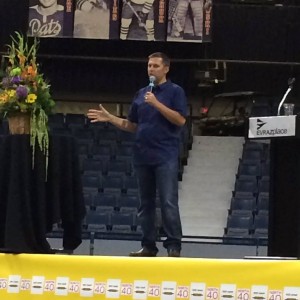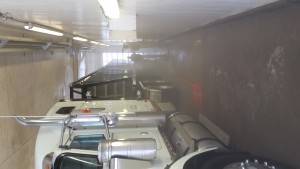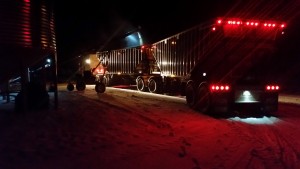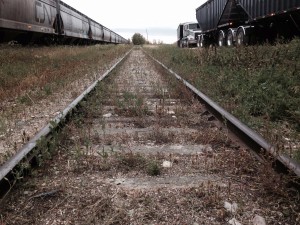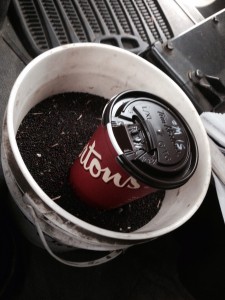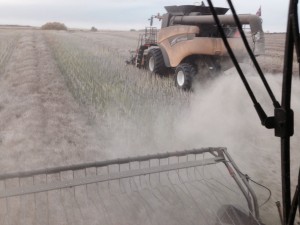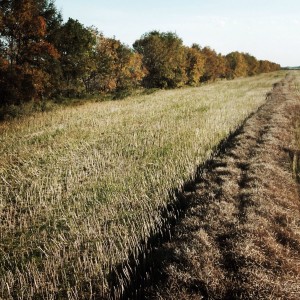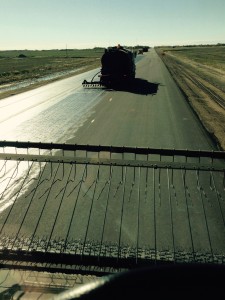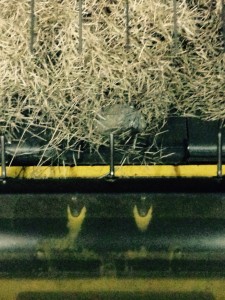AGRICULTURE IS FULL OF CAREER PATHS FOR PEOPLE FROM ALL WALKS OF LIFE
BY TAMARA LEIGH
Ask someone to name a career in agriculture, and the odds are good that the first word out of their mouth will be “farmer.” While it’s true that farming forms the foundation of the industry, those men and women are supported by a diverse and passionate network of professionals: research scientists, accountants, veterinarians, heavy mechanics, software programmers and marketing specialists, to name a few.
While only two per cent of Canadians live on a farm, one in eight jobs in Canada is related to the agriculture and agri-food industry. For Canadians looking for rewarding careers, agriculture is a growing source of career opportunities that few would associate with thetraditional image of farm life.
“I love to take a food product like potato chips and ask a group of students to describe how the bag of chips got to them,” said Becky Parker, an agriculture educator and Nuffield Canada scholar. “Most people can put together growing the potatoes, processing them into chips, and even talk about transportation. But who created the flavours? Who created the design for the bag? Those types of conversations start to open eyes to the jobs and careers that are involved in bringing food to consumers.”
Parker recently completed a study of ways to engage Generation Z, the generation born after the mid-’90s that will be entering the workforce over the next 20 years, in agri-food careers. According to Parker, Generation Z is characterized as entrepreneurial, independent and driven by the desire to have an impact with their work.
When it comes to impact, agriculture has a lot to offer. Domestically, food and beverage processing is Canada’s largest manufacturing industry, and Canada is the fifth-largest exporter of agriculture and agri-food products in the world. Globally, agriculture has the single largest footprint of any human activity, which speaks to the universal truth that everyone needs to eat. Agriculture is an economic, social, environmental, political and science-based industry, and offers career opportunities that are equally diverse.
The challenge is closing the gap between the widely held perceptions of agricultural jobs and the reality of the opportunities available. Parker said the key to getting Generation Z to think about agricultural careers when they are ready to enter the workforce is to first increase their awareness of agriculture and their exposure to the opportunities available.
“We can’t just talk about careers in agriculture with young people, we need to give them a chance to experience them through co-op placements, summer jobs or job shadowing. We need to give them an opportunity to try things out,” said Parker, who is working to create more of these opportunities in the industry. “The other key part of the system is really around mentorship, and having someone to provide a pathway into a career in agriculture.”
AGRICULTURE INNOVATION
The Faculty of Agricultural, Life and Environmental Sciences (ALES) at the University of Alberta has experienced a trend that demonstrates just how compelling agriculture can be once people make the connection.
“Our faculty gets more transfer students from other faculties than any other,” said Stan Blade, dean of the Faculty of ALES. “Students from arts or science take one of their electives from our faculty and, all of a sudden, worlds open up to them that they never conceived of.”
According to Blade, the interest from schools and students from urban areas is increasing as people begin to better understand how the opportunities in agriculture align with their values. In recent years, there has been a shift in where ALES students come from. Whereas the faculty has traditionally drawn about 75 per cent of its students from rural areas, today enrolment reflects a 50-50 split between urban and rural students. Fifty-five to 60 per cent of students enrolled in undergraduate programs are women.
“Students from places like Vancouver, Toronto and Montreal, they want to have an impact on food security,” Blade said. “They want to have an impact on the environmental sustainability of agriculture and food production more broadly.”
With a focus on experiential learning at the undergraduate level, the faculty offers international trips to places like Mexico, Cuba, India and Japan, as well as internships and opportunities to connect with top-level farmers within the region.
“We see our students go on to graduate school and equip themselves for roles as researchers and scientists,” said Blade. “We have alumni who set up their own consulting firms and agricultural businesses. Lots of our students work with companies where they work on the front line with farmers. Others go on to work with producer organizations in key positions that can become extremely influential.”
As a research faculty, the work being done at the graduate level is shaping the future of agricultural production, changing practices and creating new career opportunities in agriculture by developing demand for new skill sets.
“New research is opening up new roles,” said Blade, pointing to the “bioeconomy”—developing renewable biological resources using agriculture and forestry byproducts—as an example. “No one could foresee the bioeconomy 10 to 15 years ago, but now we have spinoff companies in our faculty looking at new materials. Companies are being formed and investments are being made because of some of that work.”
JACKS OF ALL TRADES
Agriculture and food production has changed dramatically in recent years, and the pace of change is accelerating as new technologies and production systems emerge. The increasing use of specialized software, different kinds of remote imaging, and high-tech systems to monitor crop and livestock production is becoming more mainstream practice.
Lane Stockbrugger recently left his job as a marketing specialist to farm full time with his brother near Humboldt, SK. He said the set of skills required to make a farm business work is far more complex than most people understand.
Planning crop rotations, making decisions on new technology and learning to operate it, filtering through the available research to determine what will work best for their farm, farm safety, managing staff, administration, communications and marketing the crop are all essential parts of life for the modern farmer. Beyond the farm gate, they are managing relationships with suppliers, mechanics, crop advisers, researchers, bankers, lawyers, insurance representatives and more.
“Even at the equipment dealership, the level of expertise is increasing exponentially. It used to be all heavy mechanics, now they are software engineers. The GPS systems we use were built for spaceships and adapted to our tractors,” said Stockbrugger. “People who I don’t think ever thought about a career in agriculture are being pulled in because of the technology we are working with.”
In addition to farming, Stockbrugger works as a public speaker and advocate for agriculture across the country, while also promoting Canadian wheat to international markets. In December 2016, he logged more than 20,000 kilometres of travel to present to Canadian grain customers in Algeria, Morocco, England and Italy.
“The agriculture industry has so many things going on in it right now. You may not be looking to get into agriculture, it may find you,” he said. “It’s an amazing industry to be a part of.”
BRIDGING THE GAP
According to the Canadian Agricultural Human Resource Council (CAHRC), the number of career opportunities in agriculture is growing, and expected to continue to grow over the next 10 years. The CAHRC provides labour market information to the agriculture sector and develops tools to help agricultural businesses better manage their human resource needs.
“The future for the agriculture sector is really bright,” said Debra Hauer, project manager for CAHRC. “Generally, when people think of the agriculture workforce, they think the number of people working in agriculture is decreasing. In reality, if you combine Canadian and foreign workers, our numbers show that number is going up all the time. Our forecast for the next 10 years is that agriculture needs more people to take advantage of the opportunities.”
Hauer said there are 2.3 million Canadians employed in the agrifood system from farm to plate. The number of people employed full time on-farm and in farm-support services is 403,000, including people like crop advisers, pruners, contractors, livestock service personnel and farm labourers. Research by the CAHRC and the Conference Board of Canada found there is currently a gap of approximately 50,000 farm-related agricultural jobs that need to be filled across the country. That gap is expected to increase to 114,000 in the next 10 years, in part due to farmers retiring.
Temporary foreign workers help fill the gap, but the CAHRC estimates that there are still 26,000 vacancies to be filled in Canadian agriculture.
“The majority of foreign workers work in horticulture on a seasonal basis. However, there are people brought in to be veterinarians, farm managers and supervisors in all types of agricultural operations,” said Hauer. “There are shortages across the board.”
Looking ahead, she highlighted the need for people with technical skills to design, build, operate and repair systems like robotic milking machines, drones and electronics in greenhouses that are becoming more prevalent in the industry. Consolidation in the agriculture industry is also creating a need for people with a different skill set.
“As agricultural businesses are getting larger, having more employees becomes the norm, and people need managerial and supervisory skills, as well as human resource expertise,” said Hauer. “The occupations that will be needed in the greatest numbers are managers and owner/operators because existing owners will be retiring over the next 10 years.”
OLD INDUSTRY, NEW BLOOD
At 24 years of age, Rosie Templeton is part of the younger generation that is beginning to address the labour gap, both on-farm and off. Raised in a ranching family, she found a way to combine her passions for ranching and writing and marketing by becoming a public relations strategist with AdFarm, an advertising agency that specializes in agriculture.
“I live in the city, but I still feel like I’m working with and for farmers every day,” she said. From her vantage point in an ad agency, Templeton interacts with clients from all different facets of the agriculture industry, including farmer organizations, fertilizer and seed companies, farm equipment dealers, animal health projects and even rural Internet providers.
“On any given day, I might work with five different clients who all came from a different path into agriculture,” said Templeton. “You get an inside look at a hundred different types of careers, companies and individuals within the industry that you may end up working with in the future. It is a fascinating example of how diverse the industry is.” It’s a five-and-a-half-hour commute back to the ranch from her home in the city, but Templeton still plays an active role in the family business.
“There are three girls in the family—my oldest sister is a veterinarian, I do the communications work and the other one is the active, full-time rancher,” she said. “We all have something to contribute.”
Looking ahead, Templeton echoed the sentiments heard time and again from the people who make their living in different ways in the agriculture industry. “There is an endless amount of opportunity in agriculture. It’s constantly changing, constantly adapting,” she said. “Other industries come and go, but agriculture is here to stay.”



